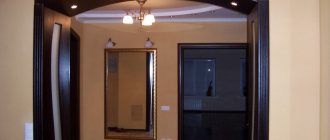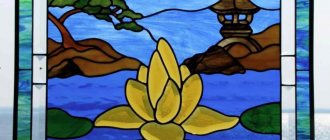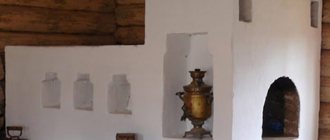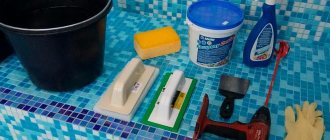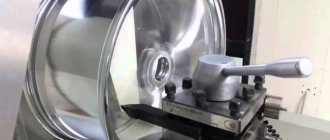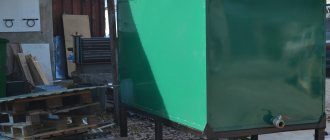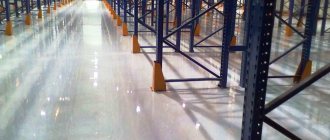Concrete is called artificial stone for its strength and durability. But even granite deteriorates over time. The frozen concrete mass has a structure with pores into which water enters, then freezes and destroys the material.
The contact sole is worn out by the shoes of the flow of people, microparticles that are harmful to health rise into the air. From an aesthetic point of view, a gray wall or path in the design looks dull. Water from the roof wears away the stone of the blind area. All of the above problems become irrelevant if you choose the right coating.
Methods for protecting unheated concrete structures
You can prevent the wear of the floor and give it an aesthetic appearance by painting. Compositions of paints and varnishes have been developed that are resistant to weather conditions and have good adhesion to concrete. However, some release toxins when dry and can only be used for outdoor use.
Others use it indoors, but the protective film is destroyed in the cold. Still others penetrate deeply into the top layer of the coating. The fourth, in the form of a water-soluble powder, is added to the batch, coloring the dough and forming bricks from it for paving stones.
In each case, a special painting technology, tools and dyes are used. The master must know where a specific paint composition can be applied, application methods, and drying time. Employees of a specialized organization will help you understand the features of paints and perform surface protection in a technologically correct manner using professional tools. The protection they provide will last a long time.
Why paint concrete
Painting is aimed at solving several problems, including dust removal and protection. Additional processing increases the comfort of staying indoors, improves the operational and external characteristics of concrete structures. On the outside of buildings, paint and varnish materials increase resistance to ultraviolet radiation, moisture, and temperature changes .
Deep painting
Deep chemical coloring systems and acid dyes work here. The advantages of this method are the ability to add color to unpainted or colored concrete. The reaction occurs on a chemical level and gives a long-lasting, unique color tone.
It is customary to distinguish two painting technologies: deep and superficial
High resistance to external influences, abrasive resistance, durability, lack of peeling, and dirt-repellent properties are observed. Among the disadvantages is the high cost, but the end justifies the means.
Surface coloring
Surface treatment is used most often. In addition to the affordable cost, we can talk about the durability and practicality of the finished coating. Paints are easy to apply, but require regular updating, in which they are slightly inferior to chemical painting systems.
Paint selection
Paints and varnishes include liquids that, when applied in a thin layer, create a protective film on the surface. All paints contain a coloring pigment in the form of a suspension, which, when dried, forms a durable elastic film. The properties of the coloring product depend on the type of solvent - varnish, oil or water. The esters released during drying have varying degrees of harmfulness. This is the defining characteristic for the place of application - interior or exterior paint.
There are aqueous suspensions:
- Acrylics are harmless polymer-polyacrylates and pigments dissolved in water. Can be used indoors and outdoors, the film is stable, the paints do not fade in the sun, applied with a roller or brush in 2 layers.
- Vinyl is a universal, quick-drying, odorless suspension that dries in 2-3 hours. The coating is abrasion-resistant, hypoallergenic, service life is 7 years. Disadvantage: low moisture resistance. Vinyl with organic solvents is a moisture-resistant coating for outdoor use.
- Rubber (latex) - water-dispersed with the addition of acrylates, dry within 20 minutes, a persistent elastic film is formed even when applied at subzero temperatures. The coating is soft to the touch. It is not afraid of moisture and serves to protect the blind area and the pool.
- Silicone emulsions based on polyorganic resins and acrylates do not accept dirt and mold, are resistant in a humid environment, the film masks cracks, durability is up to 25 years. The film is not destroyed by ultraviolet radiation and temperature changes. Divided into brands for external and internal use.
- Acrylic-silicone is used only for facade work, elastic, heat-resistant, and reasonable in terms of price and quality.
However, paints and enamels made with organic solvents form a more durable film that is resistant to sudden temperature changes. They are not afraid of precipitation or ultraviolet radiation. When drying, such paints and varnishes emit toxic compounds into the atmosphere, and their use indoors is prohibited or limited.
Paintwork materials based on organic solvents:
- Polyurethane one-component and two-component composites have good adhesion to concrete, excellent hiding power, but a long film formation period.
- Urethane-alkyd, sometimes called concrete enamels. The material has a protective life of 8-15 years with good thermal and moisture resistance. The unpleasant odor of the applied suspension remains even after drying.
- The group of epoxy enamels is distinguished by the presence of two components. Before application to the surface, a hardener is added to the liquid base composition. Enamel is universal, durable and wear-resistant. It is inexpensive, but hardens quickly.
- Mineral-based silicate paint includes potassium liquid glass. Metal oxides are used as dyes. The material is used for facade work, creating a durable, smooth film on a concrete base.
In each case, materials that meet the operating requirements are used for painting structures. Preparation of the object is important: thorough cleaning of dust, degreasing and applying a primer for better adhesion of the base material.
conclusions
How to paint concrete? For exterior work, I would recommend taking acid dyes and any organic-soluble paints. It is this solution that will be practical due to the technical characteristics of the finished layer - it is not afraid of moisture, temperature, or sun (within reason, of course). The first option is prettier and generally more reliable in terms of long-term use, especially on floors. But he is also expensive, so... If you want to save money, acrylic paint for the facade is the optimal solution, as well as silicone and silicate paint .
For painting concrete indoors, it is better to use water-dispersed paints, in particular acrylic. It works well on floors, ceilings, and walls, although in the case of the floor you will have to install an additional protective layer, but this won’t cost a pretty penny. If you want to achieve a high decorative effect, structural paints will come in handy. This is an excellent solution for walls, but its high cost is sometimes unjustified.
Practical problems of painting a concrete floor are shown in the video:
Painting of external concrete structures
Garden paths, the floor in an unheated garage or on a local area can be painted or a special composition can be used to penetrate deeply into the top layer of concrete. There is a third way - to introduce a coloring pigment into the concrete dough at the time of mixing.
Surface painting
The easiest way is to apply a surface layer of paint to a previously prepared surface. The Knauf Betonokontakt primer will help create a long-lasting protective film. Buying it in a large bucket will be cheaper, and you can even apply the composition to old paint.
A final decorative waterproof layer is applied to the previously cleaned and degreased area. They use paints and varnishes that are recommended as resistant to mechanical stress and well-tolerant of climatic operating conditions.
These include:
- water-epoxy;
- acrylic;
- polyurethane;
- rubber paints.
The film thickness will be greater and the protective period will increase when painting the surface with 2 layers of primer.
Before you start work, study the instructions for use of the product and the requirements for personal protection during work. Pay attention to how to prepare the object for painting.
Profconcrete Aqua epoxy primer paint works well on a fresh concrete floor. Consumption 200-250 g/m2. Manufacturer price 498 RUR/kg. The polyurethane product costs a hundred less, and Betonit primer-paint for external work can be purchased for 225 rubles at the manufacturer.
In open areas, cheaper substances and stains are often used instead of paintwork materials of the first group. The products are created using pigments and acrylic or acidic chemicals that penetrate the pores deep into the stone. In this case, the capillaries are sealed, the surface acquires the desired shade. For example, a stone can be artificially aged, given marbling or another effect.
Stain for concrete
Let's get acquainted with the technology of processing artificial stone with the product "Stain" of Polimix LLC. The composition is based on acrylic polymer that does not form a film on the surface. The transparent liquid is absorbed into the top layer, closes the pores, gives the surface water-repellent properties, creating the effect of wet asphalt.
Its effectiveness is secured by applying a sealant to the treated area. The stain remains in effect until the layer impregnated with it is erased. A liter is enough for one treatment of 5-6 m2 of surface, which dries within 2 hours. The cost of the product from the manufacturer is 82 rubles per liter.
In order to process a concrete path, a little effort will be required.
- Cover greens on roadsides with film or cardboard.
- Wear protective clothing and goggles.
- Spray the liquid using a spray gun. Apply several layers, allowing each layer to dry.
- After the surface has dried, treat it with sealant and rub it with a paint roller.
Other stains contain salts dissolved in weak acids. Chemical compounds react with concrete efflorescence, clog the pores with insoluble compounds and give the slab a marble texture. Epoxy suspensions are effective, but should only be used in open areas. Impregnations have a general effect: prevent water from getting inside the concrete and change its color background.
Deep coloring
If you decide to paint the stone itself, you need to use deep coloring technology. The work requires the involvement of specialists.
The concrete must be leveled, cleaned, the area fenced off, and leaks excluded. The plane is shot blasted to create roughness. The coloring composition is rubbed in with brushes in several stages. The surface should be evenly saturated, without puddles or dry areas, and left to dry for 4 hours.
Afterwards the floor is washed until neutral, dried and sealed with varnish. Deep painting allows you to create a long-lasting all-weather coating, but requires the involvement of professionals. Acid dyes cost 350 rubles/l, with an average consumption of 300 ml/m2.
Coloring concrete dough
The introduction of a coloring pigment during mixing gives the hardened artificial stone the desired color. The top layer may wear off, cracks will appear in the stone, but the color will remain unchanged. The colored monolith is used to decorate landscape designs and form tiles for laying a mosaic floor or retaining wall.
The main condition is that the coloring pigment must dissolve in the water in which the mixing takes place. You need a lot of powder to get a rich color. The main condition for choosing a powder dye is that after the concrete has set, the composition loses its ability to dissolve in water and cannot be washed out. Molded bars can be embossed, multi-colored and have a complex form of pairing of individual fragments. The result is decorative paving stones.
You can make colored concrete yourself. To do this you will need dry materials:
- white cement;
- crushed stone;
- sand;
- water;
- pigment.
The amount of coloring powder is determined experimentally. As for tools, it would be good to rent a mixer or you will have to knead manually using a shovel. This is how the kneading is done in a small volume. You will need a trowel to place the dough into the prepared formwork.
How to choose cement
White cement
If you are going to paint a concrete mixture or finished product with your own hands, then you need to pay attention to the choice of cement. The cement must be of high quality.
It is recommended to use white cement to obtain bright shades. The darker the cement, the duller the shade of the concrete will be. Before starting work, it is necessary to pre-mix a small amount of concrete mixture.
It is extremely important to maintain the required proportion of powdered dye, which is added to the composition during mixing. If you add too much of it, it will absorb moisture and the finished product may become cracked. To prevent this from happening, the addition of plasticizers and water-retaining additives is necessary.
Painting vertical concrete structures
The concrete walls of a building without finishing look boring and are defenseless against natural destroyers. Painting the outside and inside of vertical planes is not much different in technology, but different paints and varnishes are used.
Paints are called façade paints because they form elastic films that are resistant to deep sub-zero temperatures. But an indispensable condition for the durability of the material is the preparation of the base - cleaning of old layers of cladding, degreasing and priming the surface.
Selection of coloring compositions
How and what to paint the walls with depends on the type of building. The peculiarity of façade paints is that all compositions are resistant to moisture, do not fade under sunlight, and the coating does not crack in the cold. For a vertical wall, with painting on concrete, special compounds are needed, more viscous, and not flowing down during the drying period. Choose paintwork materials with a long service life that do not lose their decorative and protective properties for 10-15 years.
Functions of the front covering of the facade:
- Protecting walls from moisture penetration.
- Masking of minor defects, such as unevenness, chips, cracks.
- Compensation for movements due to shrinkage or vibration.
The choice of paint composition depends on many factors, but for everyone, preliminary preparation of the area for painting is mandatory.
For exterior finishing, choose the following compositions:
- Water-based silicone emulsion for outdoor use.
- Paints based on acrylic resins in an organic solvent. The material has good hiding power, but low vapor permeability.
- A composition containing liquid glass on a water-emulsion basis is called silicate. The coating has all the necessary properties, but is not resistant to mechanical damage. The composition is two-component and thickens quickly when mixed. As the surface hardens, it becomes transparent, but the film is not elastic, and small cracks appear when struck. But the “antique” coating looks impressive.
- Rubber or latex paintwork.
On the jar with the coloring component there must be information about what kind of work the composition is intended for and the consumption for 1 layer.
Finishing specialists know from experience which materials are suitable for specific jobs. We advise the self-taught master to select a composition that meets the requirements for finishing the facade:
- The degree of water absorption is not more than 0.05.
- Vapor permeability no more than 130 g/m2.
- Wear resistance, the number of times you swipe a rag when cleaning is 5000.
- UV resistant and self-cleaning.
- Material consumption is determined by covering power and number of layers - 0.5 - 1 l/m2.
- Drying time 2-5 hours.
Painting walls with lime or cement emulsion will cost much less. But such surfaces easily become saturated with moisture and crumble. Whitewashing will have to be repeated annually.
Tools and equipment for painting work
All work at a height above 1.5 meters is considered dangerous. Therefore, it is necessary to provide for the installation of scaffolding or platforms with fences. The coloring suspensions are stirred until homogeneous with a drill and mixer and manually with a spatula.
To remove old layers on the walls, use a metal scraper; if necessary, use a grinder to smooth the walls. The walls are ironed manually using sandpaper.
The best way to apply paint emulsion is with a spray gun. You can apply the coating with a roller or paint brush. The roller should have a long handle.
Provide a solvent for removing paint from hands and equipment. You will need a supply of masking tape to mark the boundaries of the site, and film to protect the adjacent area.
Don't forget to prepare a tray of floor paint if you are working with a brush or roller. Safety glasses and a respirator are required.
Advice: Invite professionals - painting work is inexpensive, and its quality is guaranteed.
Tools, painting equipment, protective equipment
The technology for painting concrete involves the use of spray guns, brushes, rollers, and spatulas.
Brushes
The tool is necessary for applying paints and primers. Brushes are made from several materials - synthetic fiber, bristles, horsehair . The best application is provided by samples based on animal hair, but they quickly lose elasticity and are generally short-lived. For large volumes of work, it is recommended to use brushes based on bristles and horsehair. Synthetic analogues are cheaper, but worse in shading and paint selection.
The work will require round brushes with a long handle for processing large surfaces, paneled and fluted brushes for processing junctions, hard-to-reach places and end-grain brushes for creating a rough structure on the finishing layer (if required). After use, the tool is thoroughly cleaned, which significantly extends its service life.
Rollers
Rollers are also used for applying paints and primers and significantly increase productivity. With water-dispersible and organic-soluble paints, work with smooth or textured rollers with medium pile based on cotton wool or foam rubber. Decorative compositions are worked with structural samples and spatulas.
Spray guns
Equipment for mechanized application of compounds, providing maximum labor productivity. The spray gun must be equipped with a powerful 1.5 hp compressor, with a tank of 50 liters or more . Next you will need gravity/simple sprayers and high pressure wire with regulator and filter. It is this equipment that works for economical consumption and ideal results.
Other set of tools:
- containers for mixing paints;
- painting trays;
- graters, scrapers, spatulas, hard metal brushes;
- protective tape;
- painting net, tarpaulin for flooring;
- hanging cradles, platforms, scaffolding;
- protective form.
To apply acid dyes, brushes with chemical-resistant nylon bristles are used.
Instructions for painting walls yourself
Painting the surface begins from the top point, dividing the wall with tape into separate sections. Operations are performed in cloudy, dry conditions or on the shady side of the building. The concrete is lightly moistened by spraying before painting.
Paint the surface evenly without leaving gaps. The next layer of paint is applied after the previous one has dried.
A day after the multilayer coating has dried, sealant is applied to the surface with a roller in one direction. When dry, the product becomes invisible.
Interior work on concrete floor
Artificial stone is a mass frozen into a monolith, adjacent to natural inert materials, efflorescence crystals, voids and small air bubbles. If you do not protect the monolith, structural changes will begin in it due to the ingress of water, spilled liquids, and dirt.
Application of paints and varnishes to a concrete floor will provide:
- A barrier to the penetration of water and chemically active substances into the mass.
- There is no dusting due to abrasion of the concrete layer and erosion.
- Use of reduced strength grades in construction, saving on material with optimal durability.
- Easy to maintain aesthetically pleasing coating.
When choosing a method of protecting a concrete floor using paints and varnishes, it is necessary to select the type of coating that corresponds to the operating conditions.
Compositions recommended for protecting concrete floors indoors
The development of polymer chemistry has created the opportunity to create various compositions of film-forming compounds. We advise you to pay attention to domestic manufacturers. The quality of their products is not inferior to foreign analogues, and the prices are lower. We suggest considering protective equipment, “TeoKhim”, “KrasKo”.
| Index | Mizar Akromat 200 | KrasKo Aquapol | KrasKo Texipol |
| The basis | Organic | Acrylates | Acrylic resin |
| Type | One-component | Water-based, one-component | Org. sol. one-component |
| Drying | 1 hour | 1 hour | 1 hour |
| Load | In a day | In 12 hours | In 24 hours |
| Temperature | -10 +40 0 С | From +5 0 C | -5 +30 0 С |
| Consumption g/m2 | 180-250 | 300-400 | 75-150 |
| Price RUR/kg | 275 | 190 |
Manufacturers also offer other composites designed to protect particularly loaded areas for general technical purposes. Thus, “Polybetol” can withstand temperatures from -60 to +100 and creates a protective barrier that is inert to chemicals and can withstand heavy mechanical loads.
The two-component composite “Elakor-PU EmalLux” from the TeoKhim company is a durable coating that provides chemical protection, working in open sunny areas and indoors. The composition is also used for pouring when creating a polymer floor. Cost 550 rub./kg.
We invite the buyer to study the recommendations for the use of the two-component product “AKROPUR B50” from the Mizar company. The protective properties of the material are so high that they allow it to be used in warehouses with aggressive liquids. The composite has a high hiding power, only 100-120 g/m2, which is significantly lower than imported analogues. The price of the product is only 282 rubles per kilogram.
Examples of effective protective coatings are given; there are many more of them in the catalogues. You can find the right product with the help of specialists.

